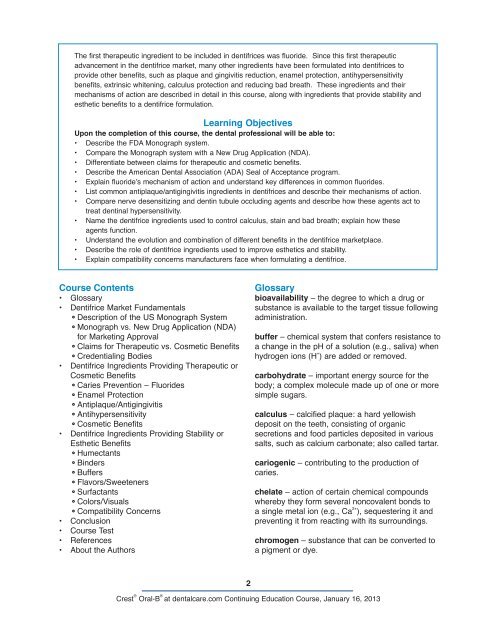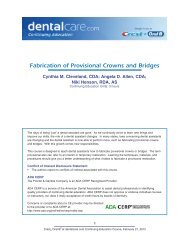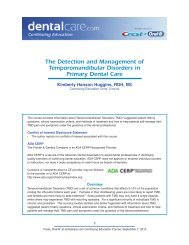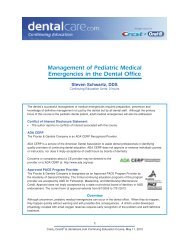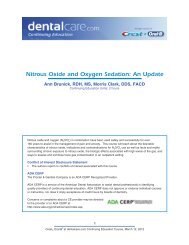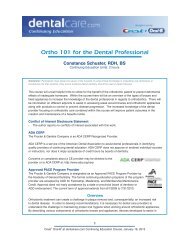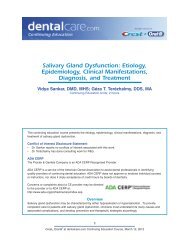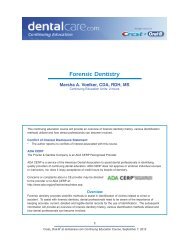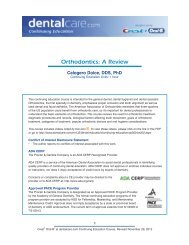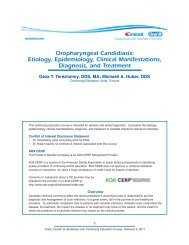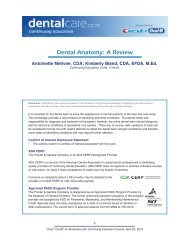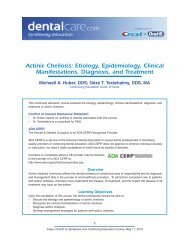CE410 - Fundamentals of Dentifrice: Oral Health ... - DentalCare.com
CE410 - Fundamentals of Dentifrice: Oral Health ... - DentalCare.com
CE410 - Fundamentals of Dentifrice: Oral Health ... - DentalCare.com
You also want an ePaper? Increase the reach of your titles
YUMPU automatically turns print PDFs into web optimized ePapers that Google loves.
The first therapeutic ingredient to be included in dentifrices was fluoride. Since this first therapeutic<br />
advancement in the dentifrice market, many other ingredients have been formulated into dentifrices to<br />
provide other benefits, such as plaque and gingivitis reduction, enamel protection, antihypersensitivity<br />
benefits, extrinsic whitening, calculus protection and reducing bad breath. These ingredients and their<br />
mechanisms <strong>of</strong> action are described in detail in this course, along with ingredients that provide stability and<br />
esthetic benefits to a dentifrice formulation.<br />
Learning Objectives<br />
Upon the <strong>com</strong>pletion <strong>of</strong> this course, the dental pr<strong>of</strong>essional will be able to:<br />
• Describe the FDA Monograph system.<br />
• Compare the Monograph system with a New Drug Application (NDA).<br />
• Differentiate between claims for therapeutic and cosmetic benefits.<br />
• Describe the American Dental Association (ADA) Seal <strong>of</strong> Acceptance program.<br />
• Explain fluoride’s mechanism <strong>of</strong> action and understand key differences in <strong>com</strong>mon fluorides.<br />
• List <strong>com</strong>mon antiplaque/antigingivitis ingredients in dentifrices and describe their mechanisms <strong>of</strong> action.<br />
• Compare nerve desensitizing and dentin tubule occluding agents and describe how these agents act to<br />
treat dentinal hypersensitivity.<br />
• Name the dentifrice ingredients used to control calculus, stain and bad breath; explain how these<br />
agents function.<br />
• Understand the evolution and <strong>com</strong>bination <strong>of</strong> different benefits in the dentifrice marketplace.<br />
• Describe the role <strong>of</strong> dentifrice ingredients used to improve esthetics and stability.<br />
• Explain <strong>com</strong>patibility concerns manufacturers face when formulating a dentifrice.<br />
Course Contents<br />
• Glossary<br />
• <strong>Dentifrice</strong> Market <strong>Fundamentals</strong><br />
Description <strong>of</strong> the US Monograph System<br />
Monograph vs. New Drug Application (NDA)<br />
for Marketing Approval<br />
Claims for Therapeutic vs. Cosmetic Benefits<br />
Credentialing Bodies<br />
• <strong>Dentifrice</strong> Ingredients Providing Therapeutic or<br />
Cosmetic Benefits<br />
Caries Prevention – Fluorides<br />
Enamel Protection<br />
Antiplaque/Antigingivitis<br />
Antihypersensitivity<br />
Cosmetic Benefits<br />
• <strong>Dentifrice</strong> Ingredients Providing Stability or<br />
Esthetic Benefits<br />
Humectants<br />
Binders<br />
Buffers<br />
Flavors/Sweeteners<br />
Surfactants<br />
Colors/Visuals<br />
Compatibility Concerns<br />
• Conclusion<br />
• Course Test<br />
• References<br />
• About the Authors<br />
2<br />
Glossary<br />
bioavailability – the degree to which a drug or<br />
substance is available to the target tissue following<br />
administration.<br />
buffer – chemical system that confers resistance to<br />
a change in the pH <strong>of</strong> a solution (e.g., saliva) when<br />
hydrogen ions (H + ) are added or removed.<br />
carbohydrate – important energy source for the<br />
body; a <strong>com</strong>plex molecule made up <strong>of</strong> one or more<br />
simple sugars.<br />
calculus – calcified plaque: a hard yellowish<br />
deposit on the teeth, consisting <strong>of</strong> organic<br />
secretions and food particles deposited in various<br />
salts, such as calcium carbonate; also called tartar.<br />
cariogenic – contributing to the production <strong>of</strong><br />
caries.<br />
chelate – action <strong>of</strong> certain chemical <strong>com</strong>pounds<br />
whereby they form several noncovalent bonds to<br />
a single metal ion (e.g., Ca 2+ ), sequestering it and<br />
preventing it from reacting with its surroundings.<br />
chromogen – substance that can be converted to<br />
a pigment or dye.<br />
Crest ® <strong>Oral</strong>-B ®<br />
at dentalcare.<strong>com</strong> Continuing Education Course, January 16, 2013


